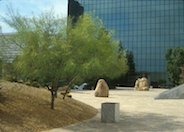
Common name:Mexican Palo Verde, Jerusalem Thorn
Botanical name:Parkinsonia aculeata
The Mexican Palo Verde has prickly stems. This tree is very fast growing with sparse foliage and very long narrow leaves. Yellow flowers with orange red throats bloom sporadically. It is very messy, thorny, weedy and short-lived. This tree is usually found on limestone soils in areas with moisture but is strongly drought tolerant. It can withstand saline conditions. It can be cold or drought deciduous. It is beautiful in form being light and airy looking, with green bark.

Common name:Sageleaf Rockrose
Botanical name:Cistus salviifolius
This low-spreading shrub reaches a size of 2' tall by 6'-8' wide. It bears white flowers that are 1" wide with yellow centers. This variety makes a good groundcover. The plant requires average to good drainage, and little or no summer watering when established. It should be grown in sun or part shade. -Monterey Bay Nursery
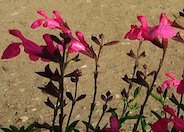
Common name:Autumn or Texas Sage
Botanical name:Salvia greggii
The Autumn Sage is a hybrid evergreen shrub that grows 3'-4' high It has fragrant green leaves and colorful flowers in shades of red that bloom in spring and summer. This lovely perennial can tolerate sun or partial shade and is hardy to 15 degrees. The Autumn Sage is drought tolerant and attracts hummingbirds. The flower colors that can be grown are: Coral, Pink, Purple, Red, and White. It can be grown near the coast and in inland warm valleys. -Cornflower Farms
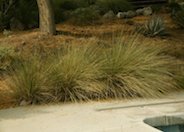
Common name:Atlas Fescue
Botanical name:Festuca mairei
Festuca mairei is a mounding grass that grows to 2-3'H x 2-3'W. The foliage is yellowish green and often browns at the tips. Is considered drought tolerant but performs better (stays greener) with fairly regular summer irrigation. Rarely blooms in the landscape in Southern California. Basically carefree.
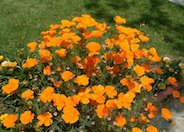
Common name:California Poppy, Golden Poppy
Botanical name:Eschscholzia californica
This small annual (sometimes acts as a perennial) plant will grow to less than 1' tall and has light, small blue green leaves with gold and orange flowers that bloom in spring and summer.
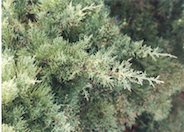
Common name:Blue Pfitzer Juniper
Botanical name:Juniperus X pfitzeriana 'Glauca'
Broad, vase-shaped evergreen shrub branches spread and angle upward can get to 20' tall. This Juniper has a moderate growth rate with feathery, gray green foliage. It needs full sun to part sun in the low desert. It is susceptible to mites, bagworms, aphids, and Juniper blight. Junipers are highly combustible plants.
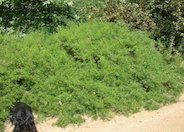
Common name:Centennial Coyote Brush
Botanical name:Baccharis 'Centennial'
This plant is a hybrid that combines a prostrate habit with tolerance for desert conditions. It grows 3' tall and 6' wide. It tolerates heat, sun and frost, maintaining its green appearance.
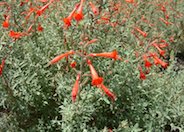
Common name:California Fuchsia, Zauschneria
Botanical name:Epilobium canum
The California fuchsia is a perennial with dense, narrow, green gray foliage and red orange summer flowers. The growth habit of this plant is sprawling and low. The California fuchsia is native to California, is drought tolerant, and attracts hummingbirds. -Cornflower Farms
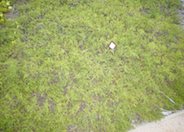
Common name:Dwarf Coyote Brush or Chaparral Bro
Botanical name:Baccharis piluraris 'Twin Peaks'
Complete with a strong, dense root system which clings attractively to slopes, this makes for an excellent low maintenance ground cover. In addition, it has no messy seeds.
| Designer: Kathryn Miller | Miller Backyard Hillside |
Photographer: GardenSoft |
Soils and Compost:
Physical weed control, including mulching, or hand removal protects the watershed from harmful chemicals.
Integrated Pest Management:
Remove irrigation water and fertilizer from areas where you don't want weeds to grow.

